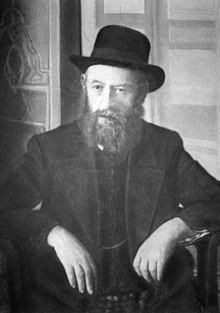Fifth Chabad Rebbe From Wikipedia, the free encyclopedia
Sholom Dovber Schneersohn (Hebrew: שלום דובער שניאורסאהן) was the fifth rebbe (spiritual leader) of the Chabad-Lubavitch chasidic movement. He is known as "the Rebbe Rashab" (for Reb Sholom Ber). His teachings that encouraged outreach were further developed later.[1]
This article needs additional citations for verification. (December 2018) |
Sholom Dovber Schneersohn | |
|---|---|
 Sholom Dovber Schneersohn | |
| Title | Lubavitcher Rebbe |
| Personal life | |
| Born | 5 November 1860 OS |
| Died | 21 March 1920 NS |
| Spouse | Sterna Sarah (daughter of Yosef Yitzchok of Ovruch) |
| Children | Yosef Yitzchok Schneersohn |
| Parents |
|
| Religious life | |
| Religion | Judaism |
| Jewish leader | |
| Predecessor | Shmuel Schneersohn |
| Successor | Yosef Yitzchak Schneersohn |
| Began | 10 September 1892 OS |
| Ended | 21 March 1920 NS |
| Main work | Yom Tov Shel Rosh Hashana, 5666, Sefer HaMaamarim, 5672 |
| Dynasty | Chabad Lubavitch |
Schneersohn was born in Lubavitch, on 20 Cheshvan 5621 (5 November, 1860), the second son of Shmuel Schneersohn, the fourth Chabad Rebbe.[2] In 1882, when his father died, he was not quite 22 years old, and his brother Reb Zalman Aharon was not much older. A period followed, during which both brothers fulfilled some of the tasks of a rebbe, but neither felt ready to take on the title and responsibilities. Over this period he gradually took on more responsibilities, particularly in dealing with the impact of the May Laws regarding the Jews, and on Rosh Hashanah 5643 (10 September 1892 OS) he accepted the leadership of the Lubavitch movement.[3]
Schneersohn married his cousin, Shterna Sara Schneersohn. She was the daughter of Rabbi Yosef Yitzchok Schneersohn of Avorutch, a son of the Tzemach Tzedek. They had one son whom they named Yosef Yitzchok after Shterna Sara's father. Yosef Yitzchok later succeeded his father as Rebbe[4]
In 1916, as the fighting in World War I neared Lubavitch, Schneersohn was deported to Rostov-on-Don. As Bolshevik forces approached Rostov he considered moving to Palestine,[5] which was part of the Ottoman Empire at the time, and prepared all the necessary paperwork; his only extant picture comes from his Turkish visa since he usually refused to be photographed. But eventually, he decided to stay in Rostov, where he died on 21 March 1920 (2 Nisan 5680).[6]
During the construction of the "Rostov Palace of Sport" on top of the Old Jewish Cemetery in 1940, his remains were secretly moved by a religious group of Chassidim to a different burial site where they are located to this day in the "Rostov Jewish Cemetery." His grave is visited daily by followers of the Chabad-Lubavitch movement, who come from all over the world.[7]
Schneersohn established the first Chabad yeshiva, Tomchei Temimim, in 1897. In 1911 he established another yeshivah, Toras Emes, in Israel, and in 1916 he established a yeshivah in Georgia. Avrum Erlich has argued that it was these institutions that made Lubavitch the dominant of the various Chabad Hasidic movements.[8]
He maintained a lengthy correspondence, not only with Chabad Chasidim in other countries, but also with non-Chabad chasidim and members of other groups who wrote to him for advice. He also met with other Jewish and Hasidic leaders, working with them on issues such as education, unity, policy, and strategy.[8] He was held in high esteem by the Chofetz Chaim, so much so that the Chofetz Chaim declared of him, "the words of the [Lubavitcher] Rebbe are holy, and anyone who argues [or] disagrees with him [should know that] it is as if he is disagreeing with Moses."[9]
Schneersohn promoted Jewish agricultural settlement, and the creation of employment for Jews, particularly those displaced by the May Laws.
He was a prominent opponent of Zionism, both in its secular and religious versions and a staunch ally of Reb Chaim Brisker. In 1903 he published Kuntres Uma'ayan, which contained a strong polemic against Zionism. He was deeply concerned that secular nationalism would replace Judaism as the foundation of Jewish identity.[10] Together with Reb Chaim he joined and supported Machazikei Hadas - a union of Eastern European haredim and the forerunner of the Agudah[6] - but in 1912, when the Agudah was formed in Katowice, Reb Chaim raised 18 objections to its constitution, and Schneersohn kept Lubavitch out of the Agudah.[11]
After the February Revolution, elections were called for Jewish city councils and a General Jewish Assembly. Schneersohn worked tirelessly to organize a religious front with a center and a special office to deal with it all. For this reason, he called a unique conference of all the Torah giants throughout Russia. This conference was held in 1917 in Moscow, and was preceded by a meeting of the leading Rabbis, to decide the matters to be discussed there. This smaller meeting was held in Petrograd. However, because the participants in this meeting were few and in a hurry to return home, the Moscow conference failed to yield proper results. Thus, it was necessary to convene once again in Kharkiv in 1918, to discuss the elections for the General Jewish Assembly.[12]
His worries about the Mountain Jews led him to send a famous Mashpia, Rabbi Shmuel Levitin of Rakshik, to the Caucasus to set up institutions to bring them closer to Orthodox observance,[2] setting a precedent for his two successors, who conducted similar activities.
Distinguished disciples of Schneersohn include R. Levi Yitzchak Schneerson, R. Itche Der Masmid, and R. Zalman Moishe HaYitzchaki.[13] The Malach.[14]
This article's use of external links may not follow Wikipedia's policies or guidelines. (January 2024) |
Schneersohn was a prolific writer on Chabad theology. Much of his work has been published in Hebrew, and some of it has been translated into English and is available online.[citation needed]
Seamless Wikipedia browsing. On steroids.